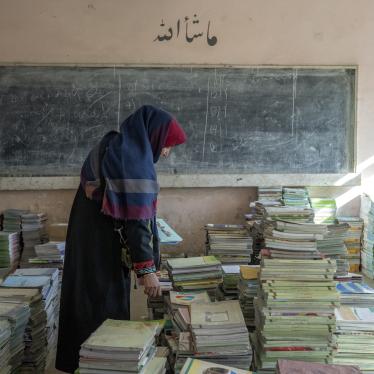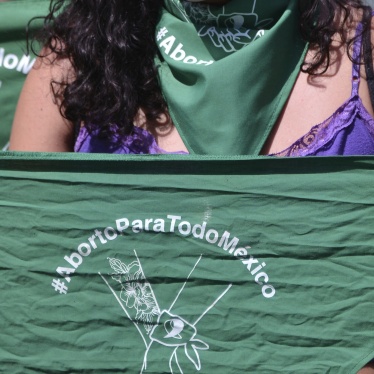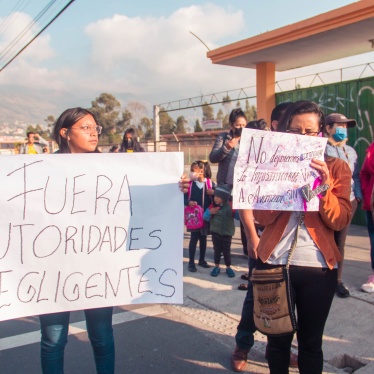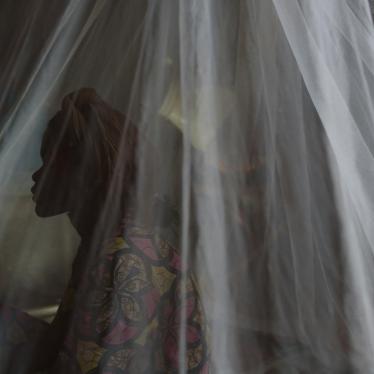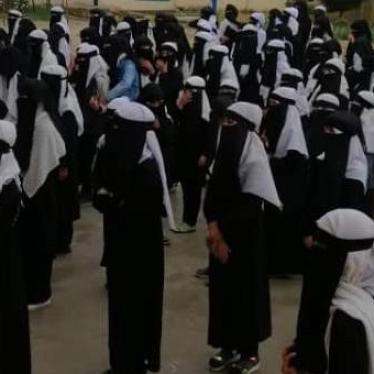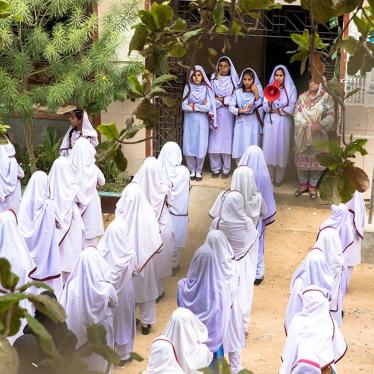Human Rights Watch Submission to the United Nations Committee on the Rights of the Child
Regarding General Comment No. 27 on Children’s Rights to Access to Justice and Effective Remedies
August 23, 2024
Human Rights Watch (HRW) welcomes the opportunity to provide input to the Committee on the Rights of the Child as it drafts General Comment No. 27 on children’s rights to access to justice and effective remedies.[1]
Human Rights Watch is an independent, nongovernmental organization that monitors and reports on human rights in more than 100 countries around the world. Human Rights Watch has documented the barriers that children, including girls and those with disabilities, face to access justice and effective remedies.
We note in this submission the existing barriers that children with disabilities face and the unique discrimination and exclusion that girls and children with disabilities experience.
I. Definitions and Understandings
Article 7(1) of the Convention on the Rights of Persons with Disabilities (CRPD) obligates States Parties to ensure that children with disabilities are able to fully enjoy all human rights and fundamental freedoms on an equal basis with other children.[2]
II. Barriers Preventing Access to Justice and Effective Remedies
Children with disabilities face many barriers to access to justice, including deprivation of legal capacity upon reaching adulthood, institutionalization, financial circumstances, lack of procedural or reasonable accommodations within the justice system, and unique socio-cultural barriers that prevent children with intersectional identities from approaching the justice system and receiving just remedies once within the system, including stigma and ableism.
A. Institutionalization in Kyrgyzstan
It is estimated that millions of people with intellectual and psychosocial disabilities, including children with disabilities, are institutionalized. This is a barrier to their accessing justice because institutional settings limit access to the community, including mechanisms for reporting abuse.[3]
In Kyrgyzstan, for example, children with disabilities in residential institutions and special schools have no true safeguards against physical or psychological violence.[4] The institutions HRW visited did not have an accessible nor a confidential complaint mechanism for children in place, creating a substantial risk that such abuses could occur with impunity. In some of the institutions, children were banned from contacting parents or guardians without staff supervision, and staff were dismissive of the need for confidential complaint mechanisms. Reporting abuse to the institution’s staff does not constitute as an independent mechanism as staff themselves may be perpetrators of the abuse.
According to Kyrgyz law, a child cannot independently take any kind of legal action, either criminal or civil, against another person without the assistance of their legal representative. Their legal representative can be a parent, adopted parent, guardian, caregiver, or a representative of the organization responsible for caring for the child, such as institution staff. The child has no say in who the court deems their legal representative, and the legal representative can only be removed from the case for a conflict of interest when the child is the perpetrator, not the victim, of abuse.
This creates a serious risk that children in institutions, whose guardians are either institution staff or parents who they might not be able to contact on a regular basis, have few defenses against potential abuse, or confidential avenues to report any abuse or neglect. This is particularly acute for children with disabilities, who may require accessible complaint mechanisms appropriate to their specific needs.
B. Practical barriers during the Covid-19 pandemic in Kenya
In Kenya, HRW documented that girls who were forced to stay at home experienced greater levels of sexual and physical domestic violence during the Covid-19 pandemic, with a staggering 301 percent increase in calls reporting violence against women and girls in the first two weeks of the lockdown between March and April 2020.[5] HRW found a critical lack of shelters, safe houses, support centers, including infrastructure that provides survivor-centered case management and individualized, ongoing psychosocial support services for survivors of gender-based violence in Kenya.
C. Abuse within the justice system in Kenya
Kenyan authorities neglected to assess the risk of lockdown measures on increased sexual and gender-based violence during the pandemic.[6] Although police authorities in Kenya have established gender desks in police stations, officers have been found to stigmatize survivors of sexual and gender-based violence, lack relevant training, and are negligent when dealing with these cases. HRW also observed that police officers have regularly demanded bribes to carry out basic functions of their job. Kenyan police and other state security agents have been key perpetrators of serious human rights violations and have been implicated in many cases of rape and other sexual violence, including of boys and girls, particularly during times of crisis.[7] Very few police officers and security agents have faced justice. As a result, these experiences have led survivors to form an impression that the police cannot be trusted and that those in charge of the gender desks would not assist them.[8]
D. Gender-based discrimination and exclusion and lack of procedural or reasonable accommodations
Access to justice is particularly difficult for women and girls with disabilities due to the stigma associated with their disability and sexuality. Girls with psychosocial or intellectual disabilities are often restrained or institutionalized for unique gender-specific reasons, such as fear of sexual violence.[9] Staff at a night shelter in Kolkata, India, told HRW that families often prefer to leave their daughters with psychosocial or intellectual disabilities in the custody of an institution where they feel they are safe, out of fear that women with such disabilities may become easy targets for sexual violence if they are at home.[10] Despite this rationale to protect girls with disabilities through institutionalization, they face new risks for violence within the institution itself and further deprivation of their liberty.
Closed institutional settings isolate children with disabilities, making violence and abuses against them difficult to discover and report. Girls with disabilities face barriers to reporting and having their criminal complaints registered and investigated in instances of sexual violence. This issue is often compounded for girls with psychosocial or intellectual disabilities, as police officers are often not convinced that the survivor is telling the truth or can identify the attackers.[11] They are also confronted with a lack of awareness and prejudice from medical and legal professionals, who often do not believe their accounts, particularly reports of sexual violence.[12]
Stigma and victim-blaming against girls with disabilities may manifest in damaging stereotypes of hypersexuality or asexuality that can have profound implications for their ability to access justice in cases of sexual violence, including having their accounts being discredited on the basis of their disability.[13] An examination of judgments from India’s appellate courts found a systematic disregard for and devaluation of the testimonies of women and girls with disabilities. This devaluation is embedded in evidentiary standards that define competency to testify and govern testimony of witnesses who are unable to speak.[14]
In 15 out of 17 cases of sexual violence HRW documented in India, provisions requiring police officers and court officials to provide accommodations were simply not followed, even in cases in which women and girls had severe and visible disabilities and injuries that they reported to the police from the start.[15]
E. School-Related Sexual Violence
Very often, children experience sexual and gender-based violence (SGBV), including school-related sexual violence (SRSV), with no recourse to justice or remedies applied at the school level to end abuses and impunity. In many contexts, perpetrators, including teachers, school staff, bus drivers and other actors connected to schools, commit sexual violence with impunity.[16]
i. Senegal
In Senegal, SGBV is widespread and vastly underreported.[17] In most small towns and villages where HRW conducted research, families frequently resolved cases of rape, sexual exploitation, and violence within their home or community, without involving either the judiciary or school. Young survivors and families hesitated to report a perpetrator or enter a judicial process for fear of isolation and stigma, which are common.[18]
HRW also found that media reports often revealed the exact identity of young survivors of rape, their location or school, and the details of the offense, which act as further deterrence to others who may want to report crime. Most parents hardly ever have access to professional, psychosocial or legal services or support to help them handle abuses committed against their children.[19]
ii. Ecuador
Historically, access to justice for cases of SRSV has been very limited in Ecuador. There is widespread impunity for cases of SGBV against girls and women in the country.[20] Two landmark cases in Ecuador, including one in which the Inter-American Court of Human Rights held Ecuador responsible in 2020, have shown a spotlight on the lengths survivors and their families must go to find justice.[21]
Access to justice is difficult for survivors and families. Obstacles to reporting begin at school, where education staff do not follow through on binding protocols, including due to lack of knowledge of protocols, prioritization of school prestige over protection of students, and a shortage of school psychologists and counselors who are responsible for responding to abuses.[22]
HRW found numerous barriers to conduct robust investigations and effective prosecutions of school-based sexual violence cases. These barriers include prosecutors and judges’ limited expertise or inexperience in dealing with SGBV cases perpetrated against children, a shortage of prosecutors countrywide and overworked staff, limited availability of experts to evaluate or accompany child complainants, and the wide breadth of crimes that prosecutors and judges must investigate and examine.[23] These structural barriers impede the timely collection of evidence and can often lead to case closures.
a. Use of Gesell Chambers
The Ecuadorian government has issued protocols on forensic interviewing methods that aim to minimize re-traumatization and the number of times a child has to retell their story,[24] but this does not always happen in practice. According to protocols, interviews with child victims should take place in Gesell chambers, a room where children are interviewed by a specialized child psychologist, while legal counsel and prosecutors observe from another room through a one-way mirror.[25] Prosecutors do not always fail to request this specialized testimony process from the judge, or judges do not grant it.[26]
As of June 2024, the Judiciary Council operated more than 100 Gesell chambers, 74 of which are currently functional.[27] In areas where there are no operational Gesell chambers run by the Judiciary Council, testimony is collected in chambers operated by prosecutors’ offices, in nearby areas, or by Zoom.[28] Children in remote rural areas far from provincial capitals must travel a long way to be interrogated in a Gesell chamber, most often at their own cost.[29]
In 2023, the government reduced the Judiciary Council’s budget compared to previous years,[30] and did not allocate funds for ongoing repairs of other Gesell chambers. The institution had to partner with national and international organizations to fund these repairs.[31]
b. Trials and Sentencing
Delays in cases due to scheduling practices, low rates of cases that reach trial, and prioritization of other crimes over SGBV are severe obstacles to ensuring survivors find swift and adequate justice.[32]
Ecuador’s “pull system” or lottery randomly assigns judges and other staff to cases,[33] which causes unjustifiable delays as it can be difficult to reconcile the agendas of judicial staff who need to be present during hearings.[34]
Prosecutors and judges in some provinces are expected to be “multicompetent,” meaning they must be able to take on a wide range of cases in addition to SGBV cases. Often, this lack of specialization means that children are not getting the appropriate attention they need during judicial processes that rely on multicompetent units.[35]
Ecuador’s institutions have made efforts to train staff on SGBV against children. However, the deep discriminatory and prejudicial challenges underscore the need for periodic and continual training and for evaluations of prosecutorial and judicial staff.[36]
Data from the Attorney General’s Office analyzed by HRW shows that of all 647 sexual violence complaints against teachers, school staff, and students between 2020 and 2022, only 2.6 percent went to trial. One case resulted in a conviction during that period.[37]
c. Comprehensive Reparations for Sexual Violence
Comprehensive reparations, including rehabilitation, compensation, symbolic or satisfactory measures, and guarantees of non-repetition of crimes,[38] are still out of reach for many child victims of sexual violence.
In Ecuador, survivors and their families have sought reparations beyond financial compensation, in the form of public apologies, access to medical or mental health services, and measures to prevent SGBV against other students. However, our previous analysis of cases based on interviews with survivors and their families showed a continued focus on providing monetary compensation.[39]
Survivors may wait years to receive reparations and compensation after very long, and most often highly re-traumatizing, judicial processes. Some survivors reach adulthood before their cases reach a sentence. Moreover, there is limited institutional ability to monitor compliance with reparations measures, lack of inter-institutional coordination, scant monetary compensation, and limited availability of mental health services.[40]
F. Recommendations
Human Rights Watch urges the Committee to call on governments to:
- Establish collective and public interest action mechanisms, such as class action lawsuits.
- Ensure the rights of child survivors and their relatives are protected throughout judicial proceedings, including by prioritizing and expediting their cases, seeking to ensure child victims only need to testify once or on as few occasions as necessary to ensure justice, conducting interviews in a room where children are interviewed by a specialized child psychologist, while legal counsel and prosecutors observe from another room through a one-way mirror, often referred to as a Gesell chamber, strictly guarding confidentiality, and providing children, including children with disabilities, and their relatives appropriate and accessible psychosocial services.
- Ensure that prosecutorial offices are appropriately staffed with professionals who are adequately trained and/or have expertise in working with children, including victims of SGBV and those with disabilities.
- Ensure there are mechanisms to monitor compliance with reparations measures for child survivors of sexual violence, including school-based sexual violence.
- Provide guidance to prosecutors and judges on monetary and non-monetary remedies, symbolic reparations, and acts of public reparations. Hold accountable perpetrators and state institutions that have failed to provide reparations.
- Provide ongoing training to all staff who provide services to child survivors and victims, including training on children’s rights, gender, SGBV, and juvenile justice. This includes all actors within the judicial system, including judges, public defenders, prosecutors, experts, and other staff. Regularly monitor and evaluate progress of these trainings.
- Ensure that all child survivors considering or entering judicial processes receive information on what services are available to them. This includes informing children in an accessible manner about their rights and ways in which to file complaints and the pathways to access medical, psychological, and legal services; and ensure they receive these services in a respectful manner, without re-traumatization.
- Ensure investigative procedures and communication with survivors and their families are accessible to people with disabilities, including children.
- Create accessible and effective mechanisms for children with disabilities in state institutions to report abuse without risk of repercussions. Ensure children’s complaints are reviewed and addressed promptly and impartially.
- Ensure reporting mechanisms and all support services are accessible for people with disabilities, including children.
- Ensure shelters and safe spaces are accessible for people with different types of disabilities and of different ages.
- Provide accommodations that are procedural and age appropriate for children with disabilities, including girls with disabilities. This may include access to a sign language interpreter, the presence of someone to facilitate communication (a “special educator”), the use of simple language, and the option to file in braille.
[1] United Nations Office of the High Commissioner for Human Rights, “Call for Submissions on Draft General Comment No. 27 on Children’s Rights to Access to Justice and Effective Remedies,” undated, https://www.ohchr.org/en/calls-for-input/2024/call-submissions-draft-general-comment-no-27-childrens-rights-access-justice (accessed August 23, 2024).
[2] UN Convention on the Rights of Persons with Disabilities (CRPD), adopted December 13, 2006, G.A. Res. 61/106, Annex I, UN GAOR, 61st Sess., Supp. (No. 49) at 65, UN Doc. A/61/49 (2006), entered into force May 3, 2008, arts. 7 and 12; and UN Committee on the Rights of Persons with Disabilities, General Comment No. 1: Equal Recognition Before the Law (Article 12 of the Convention), U.N. Doc. CRPD/C/GC/1 (2014), para. 36.
According to the General Comment on legal capacity, while article 12 of the CRPD protects equality before the law for all persons, regardless of age, article 7 of the CRPD recognizes the developing capacities of children and requires that “in all actions concerning children with disabilities, the best interests of the child … be a primary consideration” (para. 2) and that “their views [be] given due weight in accordance with their age and maturity” (para. 3). To comply with article 12, states parties need to examine their laws to ensure that the will and preferences of children with disabilities are respected on an equal basis with other children.
The CRPD also ensures the rights of all persons with disabilities, including children with disabilities, access to justice “through the provision of procedural and age-appropriate accommodations, in order to facilitate their effective role as direct and indirect participants, including as witnesses, in all legal proceedings, including at investigative and other preliminary stages.”
[3] Human Rights Watch, “It Is My Dream to Leave This Place”: Children with Disabilities in Serbian Institutions (New York: Human Rights Watch, 2016), https://www.hrw.org/sites/default/files/report_pdf/serbia0616web_0.pdf.
[4] Human Rights Watch, “Insisting on Inclusion: Institutionalization and Barriers to Education for Children with Disabilities in Kyrgyzstan” (New York: Human Rights Watch, 2020), https://www.hrw.org/report/2020/12/10/insisting-inclusion/institutionalization-and-barriers-education-children.
[5] Human Rights Watch, “I Had Nowhere to Go”: Violence Against Women and Girls During the Covid-19 Pandemic in Kenya (New York: Human Rights Watch, 2021), https://www.hrw.org/report/2021/09/21/i-had-nowhere-go/violence-against-women-and-girls-during-covid-19-pandemic-kenya.
[6] Ibid.
[7] Ibid.
[8] Ibid.
[9] Human Rights Watch, “Children with Disabilities: Deprivation of Liberty in the Name of Care and Treatment,” March 7, 2017, https://www.hrw.org/news/2017/03/07/children-disabilities-deprivation-liberty-name-care-and-treatment.
[10] Human Rights Watch, “Treated Worse than Animals”: Abuses Against Women and Girls with Psychosocial or Intellectual Disabilities in Institutions in India (New York: Human Rights Watch, 2014), https://www.hrw.org/report/2014/12/03/treated-worse-animals/abuses-against-women-and-girls-psychosocial-or-intellectual.
[11] Ibid.
[12] Ibid.
[13] Human Rights Watch, “Invisible Victims of Sexual Violence: Access to Justice for Women and Girls with Disabilities in India” (New York: Human Rights Watch, 2018), https://www.hrw.org/report/2018/04/03/invisible-victims-sexual-violence/access-justice-women-and-girls-disabilities.
[14] Saptarshi Mandal, “The Burden of Intelligibility: Disabled Women’s Testimony in Rape Trials,” Indian Journal of Gender Studies, 2013, vol. 20, no. 1, pp. 1-29. This study includes an analysis of 21 judicial decisions from India’s appellate courts, including the High Courts and the Supreme Court. Mandal directs attention to limitations in sections 118 and 119 of the Indian Evidence Act, 1872. Notably, section 119 of the Evidence Act mentioned by Mandal in this analysis was revised under the 2013 criminal law amendments.
[15] Human Rights Watch, “Invisible Victims of Sexual Violence: Access to Justice for Women and Girls with Disabilities in India”.
[16] Human Rights Watch has conducted research on SRSV and children’s access to justice and reparations in numerous countries where SRSV is widespread or endemic, and/or vastly underreported. In this section, we provide a summary of related findings on children’s limited access to justice in Senegal and Ecuador. See, for example, Human Rights Watch, Scared at School, Sexual Violence Against Girls in South African Schools (New York: Human Rights Watch, 2001), https://www.hrw.org/reports/2001/safrica/; “It’s Not Normal”: Sexual Exploitation, Harassment and Abuse in Secondary Schools in Senegal (New York: Human Rights Watch, 2018), https://www.hrw.org/report/2018/10/18/its-not-normal/sexual-exploitation-harassment-and-abuse-secondary-schools-senegal; “I Had a Dream to Finish School”: Barriers to Secondary School in Tanzania (New York: Human Rights Watch, 2017), https://www.hrw.org/report/2017/02/14/i-had-dream-finish-school/barriers-secondary-education-tanzania; “It’s a Constant Fight”: School-Related Sexual Violence and Young Survivors’ Struggle for Justice in Ecuador (New York: Human Rights Watch, 2020), https://www.hrw.org/report/2020/12/09/its-constant-fight/school-related-sexual-violence-and-young-survivors-struggle; “Like Patchwork”: Ecuador’s Slow Progress Tackling and Preventing School-Related Sexual Violence (New York: Human Rights Watch, 2024), https://www.hrw.org/report/2024/07/24/patchwork/ecuadors-slow-progress-tackling-and-preventing-school-related-sexual.
[17] See, UNICEF, “Mettre fin à la violence contre les enfants au Sénégal,” https://www.unicef.org/senegal/recits/mettre-fin-%C3%A0-la-violence-contre-les-enfants-au-s%C3%A9n%C3%A9gal (accessed August 16, 2024).
[18] Human Rights Watch, “It’s Not Normal”: Sexual Exploitation, Harassment and Abuse in Secondary Schools in Senegal.
[19] Ibid., pp. 34-48.
[20] Human Rights Watch, “It’s a Constant Fight”: School-Related Sexual Violence and Young Survivors’ Struggle for Justice in Ecuador.
[21] See Inter-American Court of Human Rights, “Caso Guzmán Albarracín y Otras vs. Ecuador, Sentencia de 24 de junio de 2020 (Fondo, Reparaciones y Costas),” June 24, 2020, https://www.corteidh.or.cr/docs/casos/articulos/seriec_405_esp.pdf (accessed June 24, 2024); See, “AAMPETRA case” and “AAMPETRA Commission” sections in “It’s a Constant Fight,” pp. 17-22.
[22] For more information, see “I. Slow Progress in Tackling School-Related Sexual Violence” section in “Like Patchwork,” pp. 26-30.
[23] For more information, see “III. Limited Progress in Access to Justice and Reparations” section in “Like Patchwork,” pp. 46-54.
[24] Judiciary Council, “Protocolo ecuatoriano de entrevista forense mediante la escucha especializada para niños, niñas y adolescentes víctimas de violencia sexual” and “Guía para la aplicación del protocolo ecuatoriano de entrevista forense mediante escucha especializada a niños, niñas y adolescentes víctimas de violencia sexual,” Resolution 116A-2018, December 14, 2018, on file with Human Rights Watch, pp. 227-293.
[25] Judiciary Council, “Protocolo para el Uso de la Cámara de Gesell,” Resolution 117-2014, 2014, on file with Human Rights Watch.
[26] Human Rights Watch, “Like Patchwork,” pp. 49-51.
[27] Letter from the Judiciary Council to Human Rights Watch, June 27, 2024, pp. 20-21, on file with Human Rights Watch; and “En la lucha por la disminución de la impunidad y revictimización en los casos de violencia sexual en Ecuador,” AECID Ecuador news release, April 2023, https://aecid-ecuador.ec/2023/04/26/en-la-lucha-por-la-disminucion-de-la-impunidad-y-revictimizacion-en-los-casos-de-violencia-sexual-en-ecuador/ (accessed June 24, 2024).
[28] Letter from the Judiciary Council to Human Rights Watch, June 27, 2024, pp. 20-21, on file with Human Rights Watch.
[29] Human Rights Watch, “It’s a Constant Fight,” pp. 57-59.
[30] “Judicatura acusa a Guillermo Lasso y a Finanzas de no proveer suficientes recursos a la Función Judicial,” El Comercio, April 6, 2023, https://www.elcomercio.com/actualidad/seguridad/judicatura-acusa-lasso-recursos-funcion-judicial.html (accessed June 24, 2024).
[31] Human Rights Watch, “Like Patchwork,” pp. 50-51.
[32] For more information, see “Trial and Sentencing” section in “Like Patchwork,” pp. 54-56 and “Obstacles During Judicial Proceedings” section in “It’s a Constant Fight,” pp. 57-63.
[33] Human Rights Watch, “Like Patchwork,” pp. 54-56.
[34] Ibid.
[35] Coalición de Niñas y Jóvenes Mujeres, Desde Nuestras Voces, “Informe alternativo al Comité de la CEDAW Examen al Estado Ecuatoriano,” October 2020, https://plan.org.ec/wp-content/uploads/2017/03/INT_CEDAW_NGO_ECU_46781_S.pdf (accessed June 24, 2024); “Like Patchwork,” pp. 52-54.
[36] Ibid., pp. 49-54.
[37] Data from the Attorney General’s Office to Human Rights Watch, February 17, 2023, on file with Human Rights Watch.
[38] Republic of Ecuador, Organic Comprehensive Penal Code, 2014, art. 78; Organic Law to Prevent and Eradicate Violence Against Women, 2018, art. 62; and Organic Law of Jurisdictional Guarantees and Constitutional Control, 2009, arts. 18-19. The 2018 Organic Law to Prevent and Eradicate Violence Against Women requires judges to include, in reparations measures, the institution that will execute the measure, the period in which it should be executed, and the compliance frequency. The law sets out the responsibilities of all institutions that comprise the National System for the Prevention and Eradication of Violence Against Women to comply with and execute reparations measures.
[39] Human Rights Watch, “It’s a Constant Fight,” pp. 64-68.
[40] Letter from the Judiciary Council to Human Rights Watch, June 27, 2024, pp. 17-18, on file with Human Rights Watch. For more information, see “Limited Follow-up on Reparations” section in “Like Patchwork,” pp. 56-58.
